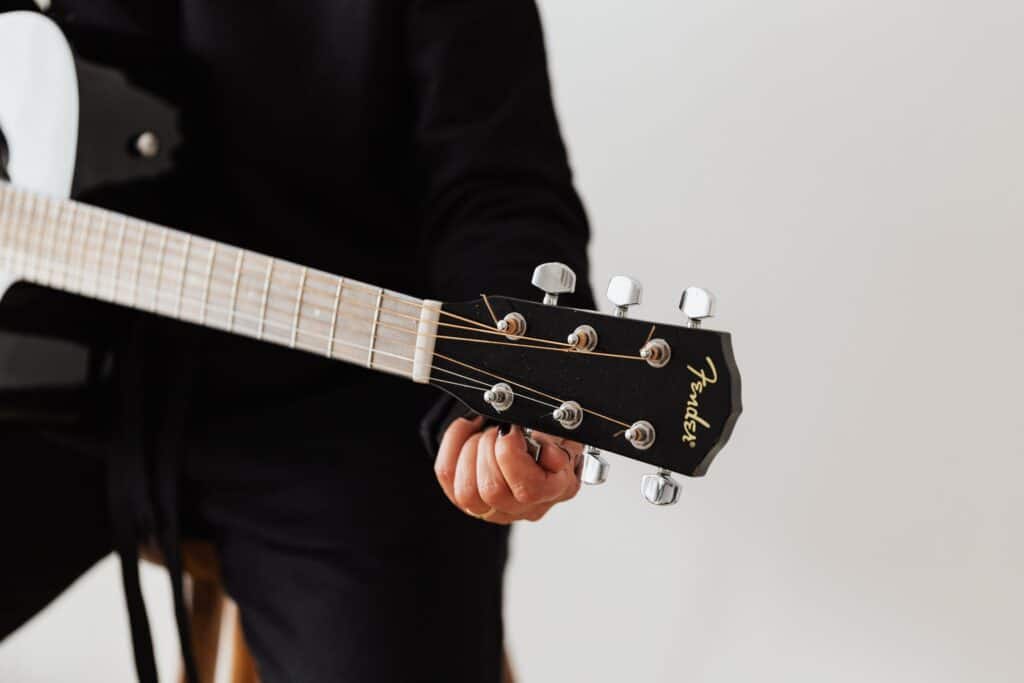
Most acoustic guitar players want to achieve a warm guitar tone at some point to imitate the sound of their favorite guitarist. While the meaning of a warm tone can be subjective, guitarists usually refer that way to tones that sound smooth and mellow.
So, if you feel like your guitar doesn’t sound warm, there are quite a few ways how you could achieve that.
To make our guitar sound warmer, we can use certain methods that will help us to achieve the tone we are looking for, such as changing the guitar strings, using a thick and soft guitar pick, adjusting the playing position and the ‘attack’ of the pick and changing the nut and saddle.
This article will explore more on these methods and their different components. If you’re interested in learning more, keep reading!
What Is a Warm Tone?

Generally, assessing a ‘warm’ sound is not easy because our ears perceive tones and sounds differently. But a general rule is that in a warm tone, the frequency range is usually 800hz to 6-7khz, and its characteristics are smooth and a mellow sound.
How To Make Guitar Sound Warmer

Making your guitar sound warmer is relatively easy, and it can be done in several different ways. Below are some methods to help you achieve the tone you’re looking for.
Change Your Guitar Strings
Guitar strings come in different gauges, and gauge is just another word to describe the diameter of the strings.
Medium gauge (thicker) strings produce a warm sound, while thinner strings produce tinny and crisp sounds.
Also, the material of your strings plays a role. Guitar strings are made from different materials ranging from nylon to steel.
But if you want to produce warmer tones, you should go for phosphor bronze strings.
Some warm sounding acoustic guitar strings are:
- Ernie Ball Earthwood Medium Light
- Elixir 16077 Strings Light/Medium (.012-.056)
- D’Addario EJ13 80/20, Custom Light
Use a Different Guitar Pick
One of the easiest ways to achieve a warmer tone is to use a different plectrum.
The guitar pick has a lot of influence over the sound and the tone because it is the point of contact with the strings.
Thicker picks are usually made from a softer material, producing a warm sound. The tip of the guitar plectrum matters a lot too. Rounded tips produce warmer sounds as opposed to a pointy tip that generates a brighter tone.
Adjust the Playing Position
Another essential factor to keep in mind is that the tone is also dependent on the ‘point’ at which we strum or pick the guitar strings with our picking hand—experiment with playing at different points. Either near the saddle and nut (bottom of the guitar) while still playing over the soundhole or closer to the guitar’s bridge.
When you’re playing closer to the bridge, you can hear that generates a tinny tone. But when you want to achieve a warmer tone, try playing the strings closer to the fretboard.
Adjusting the ‘Attack’ of the Pick
Like the characteristics of the guitar pick matter, the attack of the pick on the strings makes a noticeable difference.
Attack of the pick is basically how we hit the strings.
Hitting the strings with a lighter attack will eventually help in producing a warmer sound. To practice this method, try holding your guitar pick at an angle and not parallel to the strings. Hold the pick with a lighter grip that is not too firm but not too loose either so that the pick won’t fall while plucking the notes.
Attack on the strings with force and tension will give you a brighter sound.
Change the Nut and Saddle
This last method requires the most effort, but it will surely help you achieve a warmer sound.
Guitar strings sit in the nut. The nut holds the strings and determines the spacing between them. It is an essential piece of what makes a guitar function perfectly.
The guitar saddle sits directly in front of the bridge pins on an acoustic guitar.
The saddle and nut are essential factors between the fretboard and the strings, which also determine the guitar’s tone.
Most guitars come with plastic installed saddle and nut, producing a sharp sound.
Changing the saddle and nut to a different, softer material can help achieve a warmer tone. For this method, I would suggest contacting a luthier to find the right material saddle and nut which suits your guitar and simultaneously comprehends the tone you are looking for.
Conclusion
Guitars are pretty popular in the modern era, but learning a string instrument and getting it to sound the way you want can be a bit overwhelming.
The sound a guitar produces is a result of numerous factors. As stated before, a ‘warm’ sound is subjective and perceived differently by every guitar player.
So if you know the basics of how a guitar produces sound and the function of its different parts, hopefully, you will be able to achieve the sound you are looking for.
Frequently Asked Questions
Guitar action refers to the height of the guitar strings over the fretboard, which is the distance between the strings and the fretboard.
It is necessary to get the right action on your guitar because that will determine the feel and tone of the guitar. Generally, an action on an acoustic guitar is at around 7/64″ (2.8mm) on the low E string and 5/64″ (2.0mm) on the high E string.
Guitar Tabs or Tablature is a form system of lines and numbers which are an alternative to musical notation. The numbers (representing the specific fret) are positioned on horizontal lines which represent guitar strings.
There is no right or wrong answer to this question, The only main difference between the two is playability and feel. So choosing the right guitar to start learning depends on the sort of music you like,
However, learning an electric guitar is comparatively more costly because of the additional equipment you will need, such as a guitar amplifier and cables.









